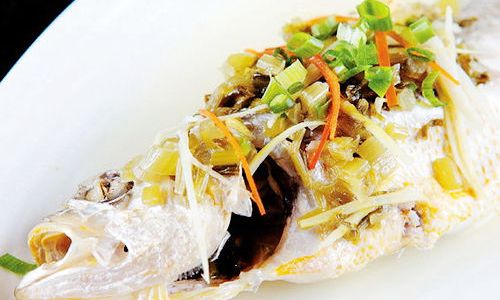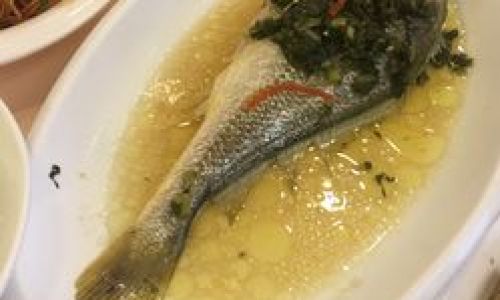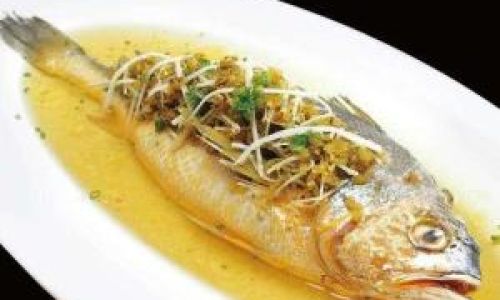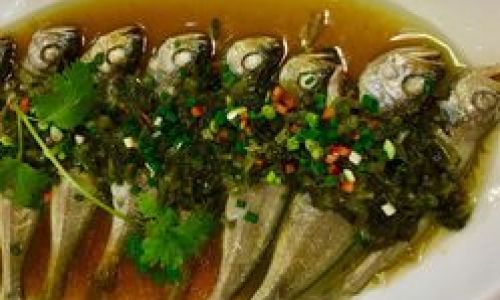Introduction
In the realm of Chinese cuisine, steamed dishes occupy a prestigious position, embodying the essence of simplicity, freshness, and harmony between ingredients. Among these, “Steamed Yellow Croaker with Potherb Mustard” stands out as a culinary gem, blending the delicate flavors of the sea with the earthy aroma of potherb mustard. This dish not only satisfies the palate but also nourishes the soul, offering a taste of coastal China’s rich culinary heritage.
Yellow croaker, known for its tender flesh and mild flavor, pairs beautifully with the pungent yet refreshing taste of potherb mustard. The steaming process preserves the natural juices of the fish, enhancing its sweetness and allowing the flavors of the mustard to meld seamlessly with the fish. This article aims to guide you through the meticulous steps of preparing this timeless dish, ensuring that every bite is a celebration of culinary artistry.
Section 1: Understanding the Ingredients

1 Yellow Croaker
Yellow croaker (Pseudosciaena crocea), also known as the golden croaker, is a popular fish in East Asian cuisine. Its firm, flaky flesh and subtle taste make it ideal for steaming. When selecting a yellow croaker, look for fish with bright, firm scales, clear eyes, and a fresh, seaweed-like odor. Avoid fish with dull scales, cloudy eyes, or a strong, fishy smell, as these are signs of freshness.
2 Potherb Mustard
Potherb mustard (Brassica juncea var. integrifolia), also known as Chinese mustard greens or leaf mustard, is a cruciferous vegetable with a strong, pungent flavor. Its dark green leaves and tender stems add a burst of color and flavor to the dish. When choosing potherb mustard, opt for bunches with vibrant leaves and crisp stems. Avoid wilted or yellowing leaves, as they indicate poor freshness.
3 Aromatics and Seasonings
The key to elevating this dish lies in the aromatics and seasonings used. Essential ingredients include ginger, garlic, spring onions, Shaoxing wine, soy sauce, sesame oil, and white pepper. Ginger and garlic provide warmth and depth, while spring onions add a hint of sweetness and freshness. Shaoxing wine enhances the fish’s natural flavors, soy sauce adds savoriness, sesame oil provides a nutty aroma, and white pepper offers a subtle heat.
Section 2: Preparation Techniques
1 Cleaning and Preparing the Fish

Begin by rinsing the yellow croaker thoroughly under cold running water to remove any scales, slime, or dirt. Pat the fish dry with paper towels to ensure even steaming. Using a sharp knife, make diagonal slashes on both sides of the fish to allow the seasonings to penetrate deeper. This also helps the fish cook more evenly.
2 Preparing the Potherb Mustard
Trim the stems of the potherb mustard, discarding any wilted or tough parts. Rinse the leaves thoroughly under cold water and drain well. To maintain the vibrant green color and crisp texture, blanch the mustard in boiling water for about 30 seconds. Immediately plunge it into ice water to stop the cooking process. Drain and chop the mustard into bite-sized pieces.
3 Preparing the Aromatics
Peel and slice fresh ginger into thin rounds. Mince garlic and finely chop spring onions, separating the white and green parts. The white parts will be used to flavor the fish, while the green parts will garnish the dish.
Section 3: The Steaming Process
1 Marinating the Fish
Place the prepared yellow croaker on a plate lined with ginger slices. This helps to prevent the fish from sticking and adds an extra layer of flavor. Season the cavity and slashes with salt, white pepper, and a drizzle of Shaoxing wine. Stuff some ginger slices and minced garlic into the cavity for added aroma.

2 Assembling the Dish
Scatter the chopped potherb mustard around the fish, ensuring it doesn’t cover the fish completely to allow for even steaming. Drizzle a little soy sauce over the fish and mustard for seasoning. Place the plate in a steaming basket over boiling water. Cover the pot tightly to trap the steam.
3 Timing is Key
Steam the fish for about 8-10 minutes, depending on its size. A good rule of thumb is to steam for about 10 minutes per inch of thickness at the thickest part. Overcooking will result in dry, flaky fish, while undercooking can leave it raw and unsafe to eat. To check for doneness, insert a fork into the thickest part of the fish; it should slide in easily and the flesh should appear opaque.
Section 4: Finishing Touches
1 Garnishing and Serving
Once the fish is cooked, remove the plate from the steamer carefully to avoid burns. Allow it to sit for a minute or two to let the flavors meld. Sprinkle the remaining chopped spring onions (green parts) over the fish and mustard. Drizzle a small amount of sesame oil over the top for a nutty, fragrant finish.
2 Serving Suggestions

Serve the steamed yellow croaker with potherb mustard hot, accompanied by a side of steamed rice to soak up the delicious juices. A dipping sauce made from a mixture of soy sauce, rice vinegar, sesame oil, and a touch of chili oil can be offered on the side for those who prefer a bit more tang and heat.
Section 5: Tips and Tricks for Perfection
1 Quality Ingredients Matter
Always use fresh, high-quality ingredients. The freshness of the fish and the vibrancy of the potherb mustard are crucial to the dish’s success.
2 Proper Steaming Equipment
Invest in a good steaming setup. A bamboo steamer is traditional and adds a subtle, earthy flavor, but a metal steamer works well too. Ensure the pot has a tight-fitting lid to retain steam.
3 Don’t Overcrowd the Steamer
Steam one fish per layer to ensure even cooking. Overcrowding can reduce the steam’s effectiveness, leading to uneven cooking.

4 Use High Heat
Bring the water to a rolling boil before placing the fish in the steamer. High heat creates intense steam, which cooks the fish quickly and evenly, preserving its moisture and flavor.
5 Resting the Fish
Let the fish rest for a few minutes after steaming. This allows the juices to redistribute, ensuring every bite is moist and flavorful.
Conclusion
Steamed Yellow Croaker with Potherb Mustard is a dish that embodies the harmony of flavors and textures in Chinese cuisine. By following the steps outlined in this guide, you can create a meal that is not only visually appealing but also bursting with layers of taste. From the careful selection of ingredients to the precise steaming process, each step contributes to the dish’s overall success.
Remember, cooking is an art form that requires patience, practice, and a love for the ingredients. With time, you’ll develop your own unique techniques and preferences, making this dish your own. So, gather your ingredients, roll up your sleeves, and embark on a culinary journey that promises not only a delightful meal but also a deeper connection to the rich traditions of Chinese cuisine. Enjoy the process and savor every bite!






0 comments